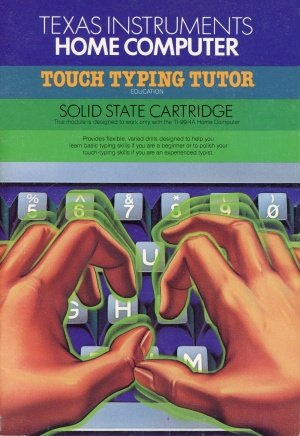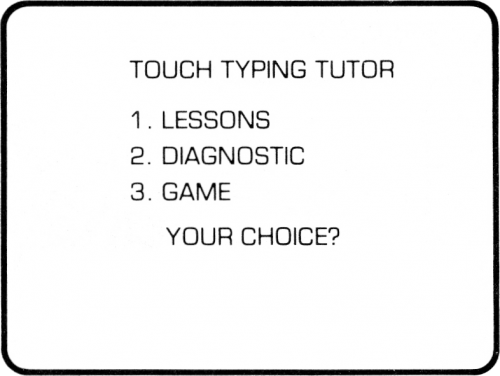Difference between revisions of "Touch Typing Tutor"
Amycjgrace (talk | contribs) |
Amycjgrace (talk | contribs) (→For The Beginner) |
||
| Line 76: | Line 76: | ||
When you complete Lesson 1-B, Review 1 begins. In this section, you type words that use the letters covered in Lessons 1-A and 1-B. When you successfully complete Review 1, you might enjoy trying Level 1 of the Game. Press '''BEGIN''' to return to the Touch Typing Tutor selection list, and then press '''3''' for the GAME. Read the instructions; then select Level 1 and get ready to type! (See the explanation for the Game on page 20.) | When you complete Lesson 1-B, Review 1 begins. In this section, you type words that use the letters covered in Lessons 1-A and 1-B. When you successfully complete Review 1, you might enjoy trying Level 1 of the Game. Press '''BEGIN''' to return to the Touch Typing Tutor selection list, and then press '''3''' for the GAME. Read the instructions; then select Level 1 and get ready to type! (See the explanation for the Game on page 20.) | ||
| + | |||
| + | All of the letter keys are covered in Levels 1 through 3. When you have completed the Lessons and Reviews in Levels 1 through 3, if you are typing at least 25 words per minute, go on to the Diagnostic section to analyze your new typing skills. If your typing speed is less than 25 words per minute, try practicing the Reviews in Levels 1 through 3 again. | ||
| + | |||
| + | ====For The Reviewer==== | ||
| + | |||
| + | If you already know how to touch-type, begin with the DIAGNOSTIC option. When the Touch Typing Tutor selection list is on the screen, press '''2''' for DIAGNOSTIC. Then press '''1''' to select WPM TIMING from the Diagnostic selection list. (See the explanation beginning on page 16.) | ||
| + | |||
| + | First, take several warm-up timings. Then, press '''BACK''' and select WPM TIMING again. After you have taken additional timings, a Target WPM is established for you. Change the target if you like; then return to the Diagnostic selection list by pressing '''BACK'''. (See page 17 for instructions on changing your Target WPM.) | ||
| + | |||
| + | Press 2 to select ANALYSIS, and then press 1 for LETTERS. Perform | ||
| + | the Keystroke Analysis as explained on page 18. The final Analysis | ||
| + | screen identifies the keys that need more practice. Take note of these | ||
| + | keys and the lessons that cover them. | ||
| + | |||
| + | Press '''BACK''' to return to the Diagnostic selection list, and press '''3''' for PRACTICE. Again, select LETTERS. This section allows you to practice individual keys, emphasizing the keys identified in the Keystroke Analysis as needing practice. | ||
| + | |||
| + | Next, return to the Touch Typing Tutor selection list by pressing '''BEGIN'''. Select LESSONS, and perform the lessons which cover the keys that were listed at the conclusion of the Analysis section. | ||
| + | |||
| + | For some fun practice, go to the Game (press '''3''' on the Touch Typing Tutor selection list), and select the level corresponding to the lessons you have just performed. | ||
| + | |||
| + | Next, work through the lessons on numbers and symbols (Levels 5 through 8). Then, work through the Diagnostic section as described above, selecting NUMBERS or SYMBOLS for the Analysis and Practice portions of the section. | ||
<div id="mp-tfp" style="margin:0.1em 0.4em 0.6em;"></div> | <div id="mp-tfp" style="margin:0.1em 0.4em 0.6em;"></div> | ||
Revision as of 02:04, 22 October 2022
| Touch Typing Tutor | |
|---|---|
 Touch Typing Tutor (Front Cover) [1] | |
| Publisher(s) | Texas Instruments (TI) |
| Original Retail Price | $39.95 (USD) |
| Programmer(s) | Susan U. Powell |
| Part# | PHM 3064 |
| Format(s) | Solid State SoftwareTM Command Module |
| Release | 1982 (2nd Quarter) |
| Genre(s) | Educational, Puzzle |
Contents
Advertising Blurbs
Front Cover of Manual
Provides flexible, varied drills designed to help you learn basic typing skills if you are a beginner or to polish your touch-typing skills if you are an experienced typist.
Triton Catalog - Spring 1984
Teaches beginning typists by using Tl-99/4A keyboard . . . and improves speed and accuracy of those who need brushing up. Includes a diagnostic section with words-per minute timing, individual keystroke analysis and practice, and an entertaining practice game.
Manual
Introduction
In this day and age, the ability to use a typewriter or a computer keyboard is almost as critical as the traditional "3 R's" - "reading, 'riting, and 'rithmetic.
The Touch Typing Tutor Solid State SoftwareTM Command Module is designed to help you learn basic typing skills if you are a beginner or to polish your touch-typing skills if you are an experienced typist. The flexible, varied drills in the module provide practice on:
- ■ Single keystrokes and letter combinations.
- ■ Over 40 frequently used word beginnings and endings.
- ■ Sentences.
- ■ Over 500 frequently used words.
The TI-99/4A computer has both upper- and lower-case characters; however, lower-case letters are displayed on the screen as small capitals. Note: While using the Touch Typing Tutor module, be sure that the ALPHA LOCK is in the off (up) position. Otherwise, certain characters will not be recognized by the computer.
The practice material for these drills is randomly generated each time you use the module. As a result, no two practice sessions are the same. The module program is organized in three major sections.
Lessons
This section teaches you the keys on the keyboard and provides practice typing words or number/symbol combinations. The alphabet keys are introduced in the first six lessons (Levels 1 through 3). Numbers, symbols, and punctuation are covered next in eight lessons (Levels 4 through 8). Following each set of two lessons is a review, which gives you practice on the keys that were covered in previous lessons, as well as the new material in the current lessons.
Diagnostic
This section analyzes your typing skill and provides practice in the areas indicated as needing more work. In the WPM (Words Per Minute) Timing tests, you can practice typing sentences and time your speed. In the Analysis portion, keystrokes are timed individually and analyzed to determine on which keys you need additional practice. The Practice portion allows you to work on individual keys, with emphasis placed on the weak keys identified in the Analysis.
Game
This section helps you increase your typing speed and provides entertaining practice on words and number/symbol combinations. Designed to correspond to the lesson levels (1 through 8), the Game utilizes graphics and a game scenario to nudge your typing speed higher and higher. The practice material in the Game includes words and combinations used in the lessons.
Getting Started
When you select the module, the title screen for Touch Typing Tutor appears. You can press any key at this time to go on, or you can wait for the title sequence to end automatically.
Next, the Touch Typing Tutor master selection list appears. This selection list offers you three options, as shown below.
Before beginning any session with the Touch Typing Tutor module, make sure that the ALPHA LOCK is in the up (off) position.
For The Beginner
If you are learning to touch-type for the first time, begin with the LESSONS option. With the Touch Typing Tutor selection list displayed, press 1 for LESSONS. See the explanation beginning on page 10 covering the lessons; then work through Lesson 1-A, which introduces the "home" keys - the keys over which your fingers should be positioned while you are typing.
If the message "More practice is needed" appears when you have completed Lesson 1-A, press REDO and repeat the lesson once. When you complete Lesson 1-A successfully, you are ready to learn the "reach" keys - those which are not in the home position. Press PROC'D to continue to Lesson 1-B.
When you complete Lesson 1-B, Review 1 begins. In this section, you type words that use the letters covered in Lessons 1-A and 1-B. When you successfully complete Review 1, you might enjoy trying Level 1 of the Game. Press BEGIN to return to the Touch Typing Tutor selection list, and then press 3 for the GAME. Read the instructions; then select Level 1 and get ready to type! (See the explanation for the Game on page 20.)
All of the letter keys are covered in Levels 1 through 3. When you have completed the Lessons and Reviews in Levels 1 through 3, if you are typing at least 25 words per minute, go on to the Diagnostic section to analyze your new typing skills. If your typing speed is less than 25 words per minute, try practicing the Reviews in Levels 1 through 3 again.
For The Reviewer
If you already know how to touch-type, begin with the DIAGNOSTIC option. When the Touch Typing Tutor selection list is on the screen, press 2 for DIAGNOSTIC. Then press 1 to select WPM TIMING from the Diagnostic selection list. (See the explanation beginning on page 16.)
First, take several warm-up timings. Then, press BACK and select WPM TIMING again. After you have taken additional timings, a Target WPM is established for you. Change the target if you like; then return to the Diagnostic selection list by pressing BACK. (See page 17 for instructions on changing your Target WPM.)
Press 2 to select ANALYSIS, and then press 1 for LETTERS. Perform the Keystroke Analysis as explained on page 18. The final Analysis screen identifies the keys that need more practice. Take note of these keys and the lessons that cover them.
Press BACK to return to the Diagnostic selection list, and press 3 for PRACTICE. Again, select LETTERS. This section allows you to practice individual keys, emphasizing the keys identified in the Keystroke Analysis as needing practice.
Next, return to the Touch Typing Tutor selection list by pressing BEGIN. Select LESSONS, and perform the lessons which cover the keys that were listed at the conclusion of the Analysis section.
For some fun practice, go to the Game (press 3 on the Touch Typing Tutor selection list), and select the level corresponding to the lessons you have just performed.
Next, work through the lessons on numbers and symbols (Levels 5 through 8). Then, work through the Diagnostic section as described above, selecting NUMBERS or SYMBOLS for the Analysis and Practice portions of the section.

